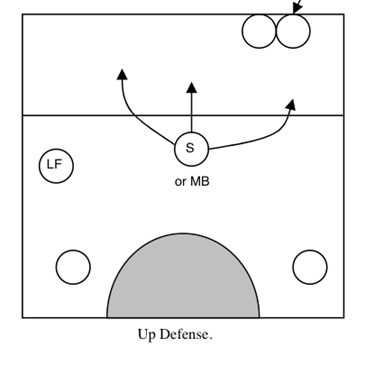| Defensive Systems
Provided by: Human Kinetics  With the advent of “rally point scoring” (scoring a point after every rally), serving, blocking and floor defense will be even more critical to the outcome of a match. A key ingredient to your team’s success will be your ability to sell your team on the concept of great team defense – blocking and digging versus just being satisfied to be a good in the attacking team. Once in a while, a coach has the luxury of watching his/her team put all the elements of great defense together at one time. I vividly remember a match in Stockton, California, on April 7, 1991, when the USA women’s team did just that against the USSR (now Russia). We continually thwarted the Soviet attack with timely blocking, precise defensive positioning and a “never quit” attitude. I can easily picture similar matches with my Ohio State men’s team (1974-76) and my University of Pacific women’s team (1976-84). The calling card of all outstanding teams is an outstanding defense. Definitions of Defense
Defense Philosophy/Concepts – for the player
Defense Philosophy/Concepts – for the coach
Four Positions 1. Starting Position GOAL = Ideally, the defenders are to be in this pre-defined (assigned) position PRIOR to the opponent’s first contact. Starting position = a defined spot for each one of the six players This position determines the defender’s area of responsibility. Make sure that the defender is in stationary position as the attacker contacts the ball. The defender must follow the ball from the moment it crosses the net to the opponent side (starting position) to the first, second and third contact of the opponent. The defender’s focus is on what is happening to the ball. GOAL = Ideally, the defender is to be in their read position, PRIOR to the attacker’s take-off.
This position locates the exact spot that the defender needs to be to intercept the ball. It occurs after the attacker contacts the ball – then the defender can move (adjust) within a range of a few feet (one to three). Remember the ball is traveling at 50 to 90 MPH (depending on the level of play) – you have very little time to react, let alone take a step or two. Thus, you must be in the right area (the correct read position) to be able to adjust a short distance in determining your exact spot. 4. Emergency Position This is the pursuit phase where you must move more than three feet to intercept a ball that has changed direction after a block deflection, an errant dig or a mis-hit by the attacker. Team Defense Systems/Patterns During the last sixty years, indoor volleyball has evolved several different defense systems/patterns. These can be put into four distinct categories:
Team Defense Systems/Patterns I firmly believe that once you understand and are able to teach the PROCESS of defense – the definitions; the philosophy/concepts for both player and coach and the four positions, you are then ready to design and implement a specific defense system/pattern for your team. Above all else, remember the importance of learning to “READ” the situation on the other side of the net. Defense has to be played before your opponent contacts the ball. Practicing all the situations that your opponent might put you in is the best way to improve your defense. Couple this concept with adequate individual defensive skills and the proper teaching of all of the points in this chapter you and your team will be well on your way to become a “great” defensive team. Just remember, no matter how skilled your players are in individual defense techniques and/or how quick they are, if they do not put themselves in the right position before contacting the ball they will not be able to become above average and outstanding defenders. Your team defense is the summation of all of your players’ abilities – physical innate talent, proper volleyball skills, and perhaps, most important, the cognitive/mental understanding of the concepts and the “way to play the game.”
|






